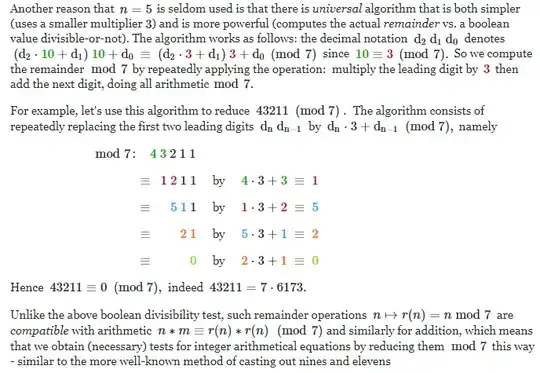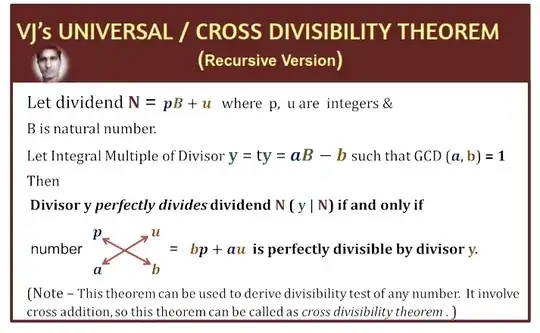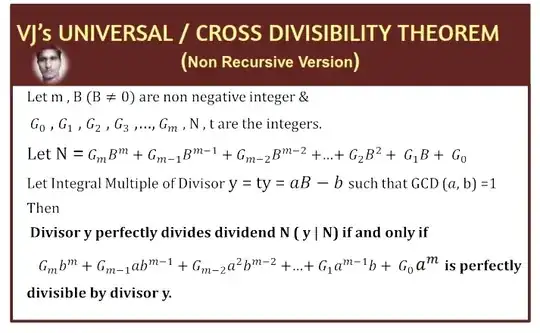The Math.SE question about the method (Why does Chika Ofili's method for checking divisibility for 7 work?) is closed as a duplicate of an earlier, more generic, question (Divisibility criteria for 7,11,13,17,19) about divisibility tests for various prime numbers. The answer by @VitthalJadhav, posted back in 2013 includes Chica Ofili's formula verbatim:
(VJ's universal divisibility test)
7|10T+U if and only if 7|(1T−2U), or
7|10T+U if and only if 7|(2T+3U), or
7|10T+U if and only if 7|(T+5U) etc.
The last line means that the number 10T+U is divisible by 7 if and only if the number T+5U is divisible by 7.
The same technique is mentioned in the article "Puzzles, Pastimes, Problems" (Mathematics in School, Vol. 16, No. 5, November 1987), by D. B. Eperson (kudos to @DavePHD for finding this link):
My alternative test for multiples of 7 is, multiply the units digit by 5, and add this to the number formed by the other digits, and if the sum is a multiple of 7, then the tested number is also the multiple of 7.
So, evidently, this is not a new mathematical formula.
Is this method memorable and easy to use? Yes
Is it cool that 12 year old derived it on his own? Yes, kind of.
Is this a new mathematical formula, discovered in 2019? No, it was posted verbatim on Stack Exchange in 2013.
Is this a new mathematical formula, discovered in 2013? No, another answer by @labbhattacharjee shows the method to derive a formula like this for any number using the basics of number theory, established in XVIII century (works of Bézout, Gauss and many others).
Another, but very similar, method to test for divisibility by 7, is posted all over the internet (1, 2, 3) and was published at least as early as 1889 (Nature volume 40, Some Properties of the Number 7, R. TUCKER):
My attention was recently drawn by a pupil to the following property, which will be best illustrated by working out a particular example:
Let N = 3425443
u2 = 342538 i.e. u2 = 342544 - 2x3
u3 = 34237 i.e. u3 = 34253 - 2x8
u4 = 3409 i.e. u4 = 3423 - 2x7
u5 = 322 and so on:
28
if any of the quantities u2, u3, u4, &c., is divisible by 7, then N is so divisible.
Unlike Ofili's teacher, R. Tucker of University College School provides proof for this test and uses it as a part of a broader theorem. Also unlike Ofili's teacher, R. Tucker doesn't give any credit to his pupil.
This is, essentially, a formula that reduces 10T+U to T-2U. With one trivial step, we can go from T-2U to T-2U+7U = T+5U.
As a matter of fact, Ofili's teacher acknowledges that "minus 2" method is well known and she found references to it while researching the problem (Chika's Test):
... And furthermore, it works if you double the last digit and then subtract it from the remaining part of the number, of if you multiply the last digit by 9, 16, 23, 30 … and subtract. And actually the doubling and subtracting test can be easily found on the internet.
But we both agreed multiplying the last digit by 5 and adding it to the remaining part of the number is much more appealing! ...
L. E. Dickson's History of the Theory of Numbers attributes this particular divisibility test to A. Zbikowski (Note sur la divisibilite des nombres (Bull. Acad. Imp. Sci. Saint-Petersbourg 3 (1861)). Zbikowski mentions T-2U manoeuvre as a special case of a broader approach to create divisibility tests for an arbitrary divisor.
P.S. This reminds me a famous anecdote about Gauss deriving a formula for arithmetic series when he was 7. It wasn't a new formula even in 1780s, but still it was kinda cool that a primary schooler derived it on his own.




 For Video explanation refer
For Video explanation refer